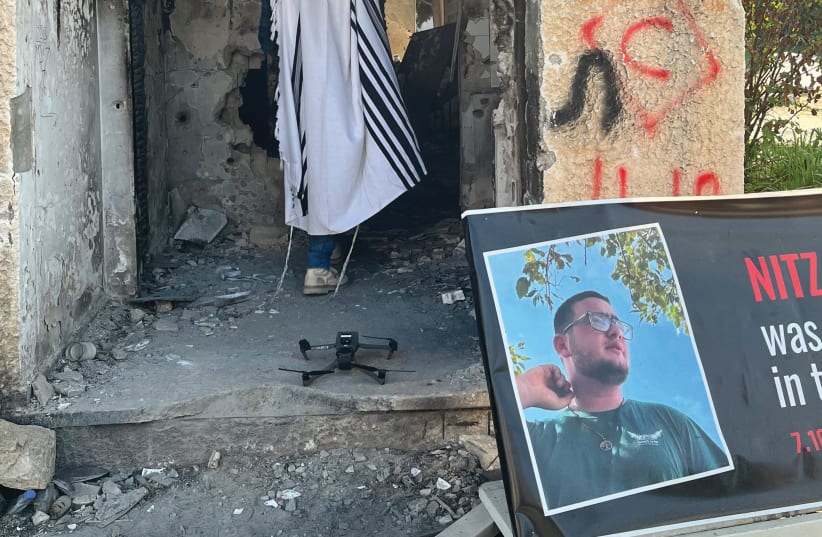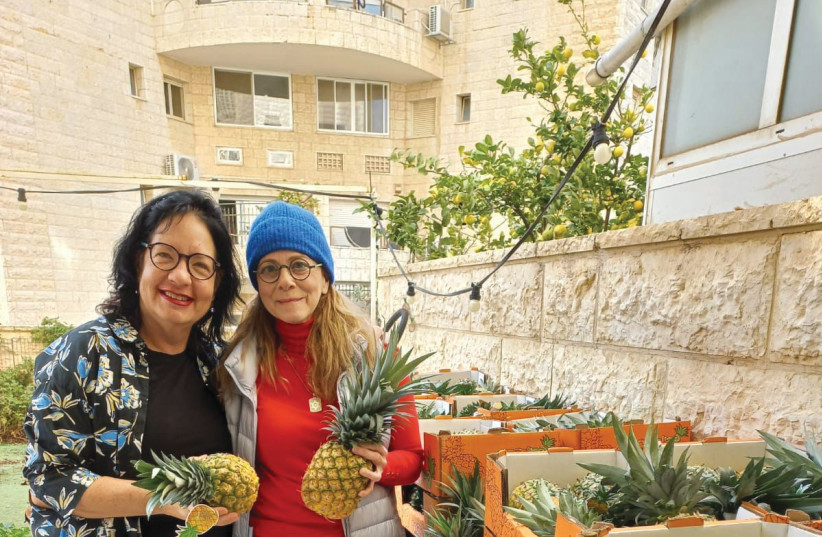Tania Hammer admits that becoming a tour guide to the South was the farthest thing from her mind when Story, her retail shop at the King David Hotel, closed its doors in June 2023.
In the aftermath of Oct. 7, Hammer set up an organization called Packages of Love and turned her apartment on Jerusalem’s Hanoch Albeck Street into a hamal (war room) where, under her supervision, volunteers packaged toiletries and supplies for soldiers.
While volunteering for Packages of Love, a woman invited Hammer to join a one-day trip led by ZAKA Search and Rescue. The Jerusalem-based international rescue unit operates a specially trained team of volunteer paramedics and professionals who had been recovering bodies almost round the clock since Oct. 7.
Hammer joined the trip, which shepherded tourists from New York’s Five Towns to the Gaza border communities, providing them with the opportunity to see the results of the atrocities inflicted upon Israeli civilians on Oct. 7.
“What we witnessed at these kibbutzim transcends mere hatred; it goes beyond any semblance of humanity. It was perpetrated by individuals devoid of any shred of soul,” Hammer told the Magazine.
On Kibbutz Be’eri, a small pink slipper sighted among the remains of a home reduced to ashes etched an enduring impression on her psyche. Motivated by a profound sense of duty, she returned to Jerusalem with an unwavering commitment to sharing the same transformative journey with as many people as possible.
In partnership with ZAKA, Hammer created the Vehi She’amda tour, taking the name from the passage in the Passover Haggadah that tells the story of the Jewish people and their survival. (She now goes out on her own.)
The tour itinerary covers stops at kibbutzim in the Gaza border area to bear witness to the atrocities; morale-boosting visits to soldiers entering and leaving the Gaza Strip at a field army base; stops at the Supernova festival massacre memorial site in Re’im; and at the car graveyard outside Kibbutz Tekumah.
“Taking people down to the Gaza envelope is such an enriching experience because they get to see the side of humanity they otherwise wouldn’t see. To see [the results of] such hatred but balance them out with meeting the soldiers is so uplifting,” she said.
Hammer had quietly shared details of her first day trip to the Gaza border area with a small group of friends and volunteers on a WhatsApp group. News of her tour went viral, with more than 100 English speakers joining the group overnight to grab the limited spots available on the next tour. These are booked on a first-come-first-serve basis, and tours fill up quickly; registration is completed via a form on the ZAKA website.
ON A recent trip to the South, I joined a group of English speakers that included tourists from the United States and Canada, as well as olim (immigrants) who live in Jerusalem and Modi’in and other areas of the country with Anglo enclaves. We boarded VIP vans and headed toward the war. Passing an army checkpoint, the vans rolled through the heavy yellow gates of the entrance to Kibbutz Kfar Aza.
At first glance, many of the homes appeared untouched, until the first house that had been reduced to rubble came into view. Situated amid the bucolic backdrop of citrus and cedar trees, the burnt-out shell of a two-story home was a shock to behold.
The vans continued down the road for a few minutes toward the back of the kibbutz, where they stopped inches from the rear gate. ZAKA volunteers attired in gowns and booties emerged from a truck just as the group disembarked and gathered at the spot the terrorists had breached on Oct. 7.
Black smoke billowed across the short distance from the Gaza Strip as military drones hummed overhead. The unmistakable symphony of attack helicopters blended into the surreal soundtrack that marked the beginning of the tour.
The group walked toward the rows of small houses to meet up with their tour guide, Simcha Greinman, a deputy commander in ZAKA and one of the organization’s most recognizable faces since the massacre. He gave testimony at a December 4, 2023, United Nations session dedicated to exposing the sexual violence committed on Oct. 7. Greinman has since been quoted extensively in media outlets across the globe. He led the group through the horrific events of Oct. 7 as they walked past and through the remains of what had been the homes of young adults on Kibbutz Kfar Aza.
Posters of smiling young faces above texts in Hebrew and English plaster the remains of multiple homes with spray-painted markings on their walls. The stuffing from ripped mattresses, shards of broken glass, shreds of torn clothing, and pieces of broken pottery are strewn across the courtyard.
THE ACCOUNTS of horror and heroism were detailed and disturbing.
Greinman explained the meanings of markings on the door frames and walls. Red circles with a dot mean that bodies had been found inside. Triangles with the letter “C” mean that the houses were clear. The group was instructed not to take photos or videos inside many of the houses on the kibbutz.
However, we were allowed to document the home of Sivan Elkabets and her boyfriend, Naor Hasidim, whose parents created a memorial to the brutally murdered young couple. In the bedroom/safe room where the couple had tried to hide, a video playing on a loop illustrated what their home looked like immediately after Oct. 7. With gunshots and bombs exploding in the distance, we were unsure whether we were hearing the sounds of war in the moment or from footage filmed weeks earlier.
Photos of the couple in happier times hung across bullet-riddled walls, along with an enlarged printout of the last WhatsApp messages shared between the couple and their loved ones. At the entrance to the destroyed kitchen, a book lay open, inviting visitors to write notes of strength and prayer for the surviving family members.
ONE OF the smaller houses with significant signs of damage was the home of Nitzan Libstein, 19, murdered on Oct. 7. Before guiding the group through the remains of his home, Greinman shared the series of events that led to Nitzan’s murder. A Jerusalem resident on the tour asked Greinman how he knew the exact sequence of events that led to Nitzan’s horrific death.
“GoPros,” Greinman responded. “The terrorists filmed it all.”
The group spent a couple of hours touring that decimated area of the kibbutz, with the breadth of destruction overwhelming many of the participants.
After the scenes witnessed at Kibbutz Kfar Aza, the group unanimously voted to move on to the next stop on the tour.
THE ARMY field base is a large, unpaved area that serves as the access point where IDF soldiers and supplies enter and leave the Gaza Strip. As the group gathered eagerly to greet the soldiers, the somber mood lifted. The number of soldiers arriving swelled as vehicle after vehicle left the Strip to cheers from the group, who approached the truck windows with treats, also throwing candy, protein bars, and even beef jerky into the backs of the vehicles.
After an hour spent boosting soldier morale, the group boarded buses heading to the third stop of the tour, the memorial to the victims of the Supernova massacre at the festival campsite. On the road to the memorial near Kibbutz Re’im, one person pointed out the roadside bomb shelter where Jerusalem’s Hersh Goldberg-Polin was kidnapped and where Aner Shapiro heroically fielded seven hand grenades before being killed.
The group soon realized that the road they were traveling was the main artery out of the Supernova party, Route 232, the road that hundreds of terrorists had flanked, ambushing and killing scores of innocent people on that terrible day.
Blow-ups of countless young faces sit atop poles in the field, forming a maze. Once animated in dance, the crowd now stands frozen. Among them, 367 souls are commemorated, alongside images of 40 festival-goers abducted into Gaza. The frozen maze has no clear beginning or end, and navigating it presents visitors with a challenge to honor each victim.
Many members of the tour ventured out into the empty fields and through the trees to experience a deeper understanding of the festival-goers’ vulnerability, with nowhere to run or hide from the relentless pursuit of thousands of terrorists.
The group arrived at the car graveyard outside Kibbutz Tekumah at sunset, where more than 3,000 vehicles in various states of destruction stand. ZAKA has been working with the Israeli Chief Rabbinate to determine what to do with these remains, since so many of the cars contain the ashes of victims that have been impossible to collect and yet need to be disposed of in a dignified manner.
At the entrance to the car graveyard, hundreds of scorched vehicles are stacked; twisted metal pieces making it barely possible to distinguish one car from another. The husk of a burnt Hatzalah ambulance, hood up to reveal the remains of its engine, rests indefinitely behind police tape. Two police officers guard the area as visitors arrive in a couple of cars and stop to take photos and videos and absorb the magnitude of the destruction.
Overhead, two attack helicopters hovered before one shot a missile toward the Gaza Strip, the boom causing multiple members of the group to jump. The tour was over.
“WE’RE SUPPOSED to remember the exodus from Egypt every day, but it’s a memory ingrained in our DNA,” said Hammer.
Yet “For the people embarking on this tour and then encountering these stories in the Haggadah, the significance becomes palpable. It’s not just a historical event; it happened to our brothers and sisters. Hakadosh Baruch Hu matzileynu meyadam, ‘God save us from enemy hands,’ is evident in these brave soldiers risking their lives,” she said.
“While we acknowledge that not everyone may be saved, we know that God will save us collectively as a nation.”

